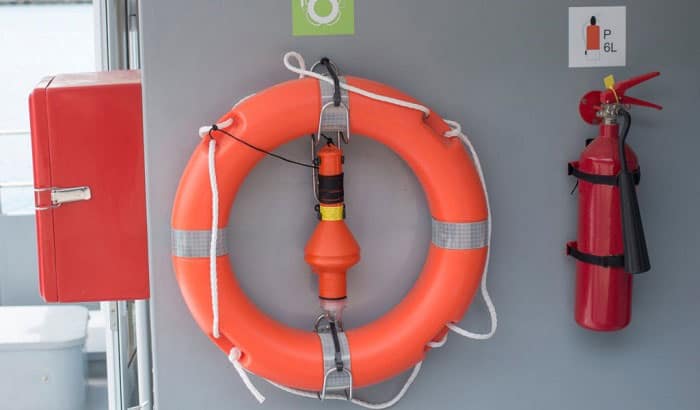A fire extinguisher should be stored in an easily accessible location on a boat. It is typically mounted near the helm station or in a cabin.
A fire extinguisher should be stored on a boat in an easily accessible location. The best place for a fire extinguisher is near the helm station, where it can be reached quickly in the event of a fire. Other good locations include the galley and engine room.
Quick Navigation
Fire Extinguishers For Your Boat
Where Should You Store a Fire Extinguisher?
When it comes to fires, every second counts. That’s why it’s so important to have a fire extinguisher readily available in case of an emergency. But where is the best place to store a fire extinguisher?
Ideally, fire extinguishers should be stored in an easily accessible location near the potential fire hazard. For example, if you have a kitchen stove, you might want to keep a fire extinguisher in the kitchen cabinet closest to the stove.
It’s also important to make sure that everyone in your household knows where the fire extinguishers are located and how to use them properly.
In case of a fire, time is of the essence and you don’t want anyone fumbling around trying to find an extinguisher or using it incorrectly.
So, when it comes to storing fire extinguishers, accessibility and familiarity are key. By following these tips, you can help ensure that you and your loved ones are prepared in case of a fire.
Does a Fire Extinguisher Have to Be Mounted in a Boat?
There are many types of fire extinguishers, and each has its own specific set of instructions. In general, however, all fire extinguishers must be mounted in a boat in order to be effective. This is because a fire extinguisher needs to be close at hand in order to be used quickly and effectively in the event of a fire.
Additionally, mounting a fire extinguisher in a boat ensures that it will not be lost or damaged during transit.

Credit: www.ridetheducksofseattle.com
What Does the Letter B on a 5B Fire Extinguisher Indicate
The Letter B on a 5B Fire Extinguisher Indicates the Class of Fire That the Extinguisher is Designed to Put Out. The Classes of Fire Are as Follows:
Class A – Ordinary combustibles such as wood, paper, cloth, and trash
Class B – Flammable liquids such as gasoline, oil, and grease
Class C – Energized electrical equipment such as appliances and wiring
Where Should Fire Extinguishers Be Stored in a House
When it comes to fire extinguishers, there are a few things to keep in mind. First, you want to make sure that they are easily accessible in case of an emergency. Secondly, you’ll want to ensure that they are properly stored so that they will be ready for use.
Here are a few tips on where to store fire extinguishers in your home:
1. The most obvious place to store a fire extinguisher is near the kitchen. This is because the kitchen is one of the most common places for fires to start.
If you have a small home or apartment, you may want to consider storing one under the sink or in a cabinet near the stove.
2. Another good spot for a fire extinguisher is near the fireplace or wood stove. Again, this is because these are common places for fires to start.
If you don’t have either of these in your home, another good option would be near an exit door.
3. You’ll also want to make sure that any children in your home know where the fire extinguishers are located and how to use them properly. Teach them about Fire Safety and go over what they should do if they see a fire starting.
It’s also important to check the expiration date on your extinguishers and replace them as needed – usually every five years or so.
Which Class of Fire Extinguisher Should Be on Board a Vessel With a Permanently Installed Fuel Tank
There are four main classes of fire extinguishers that are suitable for use on board a vessel with a permanently installed fuel tank: Class A, Class B, Class C, and Class D. Each class is designed to extinguish a specific type of fire, so it’s important to choose the right extinguisher for the job.
Class A fire extinguishers are designed for fires involving combustible materials like wood, paper, or fabric. They work by cooling the burning material and smothering the flames.
Class B fire extinguishers are designed for fires involving flammable liquids like gasoline, oil, or paint. They work by creating a barrier between the fuel and the oxygen in the air, depriving the fire of one of its key components.
Class C fire extinguishers are designed for fires involving electrical equipment.
They work by interrupting the flow of electricity to prevent further ignition.
Class D fire extinguishers are designed for fires involving metals like magnesium or titanium. They work by creating a vapour-smothering blanket over the burning metal to deprive it of oxygen.
Conclusion
It is important to have a fire extinguisher on board your boat in case of an emergency. But where should you store it? The best place for a fire extinguisher is in a location where it is easily accessible in case of an emergency.
A good place to store a fire extinguisher is in the cockpit, near the helm station.
Leave a Reply